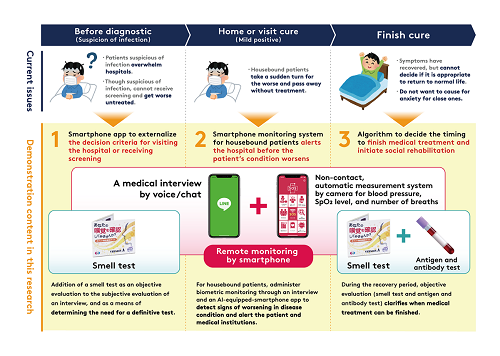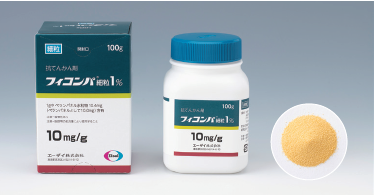news – page 14 – eisai china lnc.-威尼斯人888
preventing medical infrastructure collapse by a monitoring system linked to line
allm inc. (shibuya-ku, tokyo, president: teppei sakano, hereafter allm), tokyo medical and dental university (bunkyo-ku, tokyo, president: yujiro tanaka) and eisai co., ltd. (headquarters: bunkyo-ku, tokyo, ceo: haruo naito, hereafter eisai) announced that their jointly submitted study and development project has been selected by the japan agency for medical research and development (amed) for its publicly advertised 2020 “field of support for experimental study on medical devices and systems that contribute to measures against viruses and other infectious diseases” as part of its “technology development project for measures against viruses and other infectious diseases “, and that allm has entered into an industry-academia-government joint research agreement with tokyo medical and dental university and eisai respectively.
the selected study and development project is as follows:
study of the monitoring system for covid-19 patient on the home/hotel recuperation.
representative organization: allm inc.
duration of study and development: from grant delivery decision date during 2020 until march 31, 2021 (1 year).
(reference) amed website (japanese only)
■summary of the experimental study
since april 2020, allm has been operating a medical treatment administration system linking the communication application “line” and the medical information collaboration system “team”, developed and operated by allm, for use in treatment of patients with mild cases of the novel coronavirus infection at home or in accommodations in kanagawa prefecture. on the other hand, while vital signs such as body temperature in addition to blood pressure, respiratory rate, and spo2 are indispensable for the physical management of medical care recipients, measurement equipment supplies were not sufficient. accommodation care facilities were insufficient such that among patients testing positive, those with mild symptoms or without symptoms had to share accommodations. provision for patients receiving treatment at home was even more difficult. with predicted increases in patients yet to come, establishment of a system to allow for arrangement of secure medical treatment at home became an urgent task. therefore this study will apply widely used smartphone and sns technologies and add a function that allows for remote acquisition of various data that contribute to medical decision making to an existing communication system, without requiring special knowledge or equipment from users. demonstrations are planned in kanagawa prefecture and tokyo metropolis.

this study will first implement a non-contact body monitoring function in the lifesaving and health support application “mysos” developed by allm. this function is equipped with ai to measure vital signs including spo2, respiratory rate, and blood pressure using a smartphone camera.
the vital information obtained by this function is applied to optimize the content of a medical inquiry, sent to the patient through line chat, according to the patient’s condition. in addition, the following three points will be verified by combining an olfactory test (classified as miscellaneous goods) provided by eisai with other commercially available antibody tests and antigen tests, under the supervision of tokyo medical and dental university:
-
- designation of remote assessment criteria for patient consultation to eliminate patient anxiety and prevent inundation of medical institutions
- construction of an alert system that predicts serious deterioration, in order to prevent sudden changes and serious deterioration of patients receiving medical treatment at home.
- designation of criteria for determining when medical treatment may be ended and the patient may return to society
this study aims to make a great contribution to solving problems in the medical field by enhancing communication with medical institutions through ai and ict in situations where the work of medical institutions and public health centers is saturated and patients’ anxiety is amplified due to the rapid spread of infection.
■ about amed’s “technology development project for measures against viruses and other infectious diseases”
in response to the global spread of the novel coronavirus infection (covid-19), expectations are high for the development of simple, rapid and decentralized virus tests, systems for preventing the spread of infection, and development of therapeutic devices for critically ill patients. in light of these expectations, we will support research and development that will lead to the resolution of problems caused by infectious diseases, as well as the development and verification of equipment and systems that meet the needs of the field for measures against the novel coronavirus infection.
■ about mysos
mysos is an application developed and provided by allm inc. that records the health and medical records of patients and their families, and supports a smooth response in the event of an emergency. since mysos allows for medical examination results and medical images such as mri and ct to be checked via smartphone, this app can also be used as a phr (personal health record) and may thus play a role in daily health management.
■ about team
team is a solution developed and provided by allm inc. that seamlessly connects medical and nursing care services and supports the promotion of a regional comprehensive care system. it enables information sharing and collaboration among professions based on operation records stored in the applications “kaigo” and “kango” for the nursing care business and the nursing business, respectively.
■ about allm
allm inc. has cited “shaping healthcare” as its corporate message, as a company that “supports all medical care (all medical)” through providing mobile ict solutions in the medical and welfare fields. in addition, in the medical ict business, including the application “join” for communication among medical personnel, we are actively engaged in global expansion and providing solutions to 19 countries as a medical ict company originating in japan.
- company name: allm inc
- head office: yushin bldg. shinkan 2f, 3-27-11 shibuya, shibuya-ku, tokyo, zip code: 150-0002 japan
- representative director/ceo: teppei sakano
- founded: april 18, 2001
- capital: 1,541,650,000 yen
- website:
※mysos and team are trademarks or registered trademarks of allm, inc.
■ about tokyo medical and dental university
tokyo medical and dental university was founded in october 12, 1928 as the administration, in the yushima/shohei hill area of tokyo famed as a place for education and learning. through the blending of medicine and dental medicine, tokyo medical and dental university was created as the only comprehensive medical institution in japan under the slogan “carpenter of knowledge and healing”, practicing innovative medical care in japan and contributing to the health of individuals and the welfare of society. for more information, please visit the university website:
■ about eisai
eisai co., ltd. is a leading global research and development-based pharmaceutical company headquartered in japan. we define our corporate mission as “giving first thought to patients and their families and to increasing the benefits health care provides,” which we call our human health care (hhc) philosophy. with approximately 10,000 employees working across our global network of r&d facilities, manufacturing sites and marketing subsidiaries, we strive to realize our hhc philosophy by delivering innovative products to address unmet medical needs, with a particular focus in our strategic areas of neurology and oncology. as a global pharmaceutical company, our mission extends to patients around the world through our investment and participation in partnership-based initiatives to improve access to medicines in developing and emerging countries.
for more information about eisai co., ltd., please visit .
contact information:
allm inc. team
platform department pr
tel: 03-6418-3012
email: press@allm.jp
national university corporation tokyo medical and dental university
tel: 03-5803-5833 fax: 03-5803-0272
email: kouhou.adm@tmd.ac.jp
eisai co., ltd.
pr department
tel:03-3817-5120

